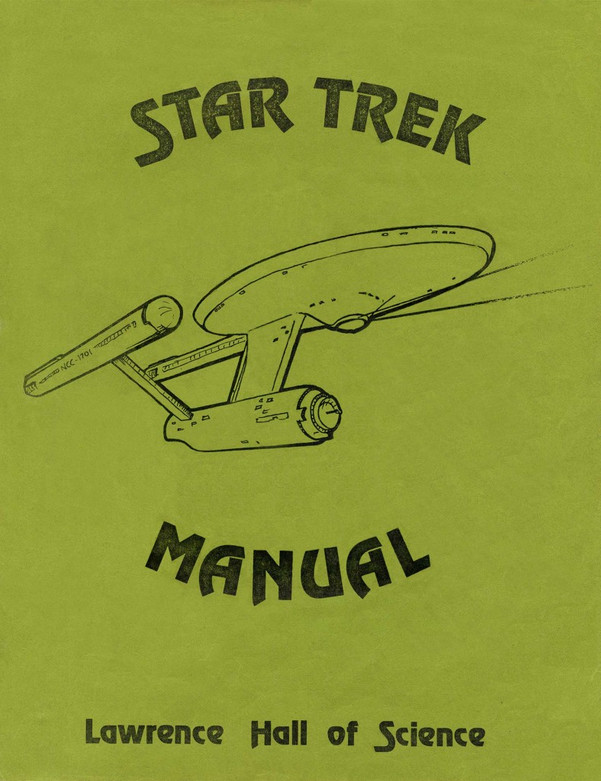
– Well Lieutenant Narwhal. We have received your next assignment. Congratulations ! You will be transferred to the USS Enterprise. Good old NCC-1701. Again.
– Again.
–I have to warn you, your mission will probably involve aggressive alien races.
– Again. Are those the Klingons or yet another unlicensed variant like the Klargons or whatever ?
– Ooooohh No ! Don’t worry ! You will fight Gorns.
– I will fight what ?
– Remember that one weird alien race that Captain Kirk met exactly once and fought in slow motion in Season 1 episode 18 ? That was a Gorn. As I said, totally canon material.
William Char’s Trek73 is the less successful, more niche little brother of the popular Star Trek (“STTR1”) game. Where STTR1 is about exploring the galaxy and mass-destroying Klingons in a few key-strokes, Trek73 fully forgoes the strategic situation and focuses only on tactical combat.
Char coded the very first version (called $SPACE) in January 1973 on San Francisco’s Wilson High School’s HP2000C (a mainframe computer). Later in 1973 with some friends (Perry Lee and Dan Gee) he improved it until they got a version they were happy with in October : Trek73. It was time to disseminate it, and in 1973/1974 there was no better way to do that than People’s Computer Company [PCC] :
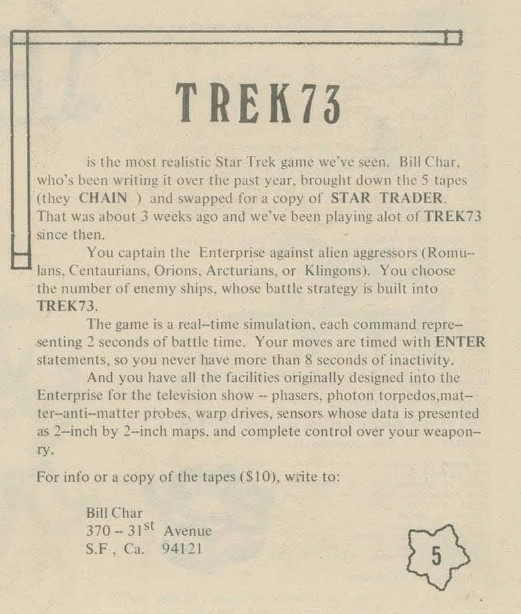
The PCC was at that point in time in full craze for Star Trek games (Mayfield’s game had started to be widely disseminated in early 1973) so such a description was bound to find some takers. One way or another, a version made it to Roderick Perkins, who ported the game to the HP2000C at the Lawrence Hall of Science in UC Berkeley, a terminal that was connected remotely to the computers of many schools in the San Francisco Bay Area. If you had a teletype and could get access to a terminal itself connected to the Lawrence Hall of Science, then you could play Trek73.

With both the Bay Area and the PCC covered, Trek73 cornered most of the market of trekkies who had a knack for making their own variants of Star Trek games. There would be many debates on which one was the better Star Trek, and quite a few people in PCC would claim to have coded a game combining the best of both !

Yet, Trek73 was more complex, more CPU-greedy and hence less suited for modifications than Mayfield’s Star Trek. Trek73 quickly had variants for mainframe computers but it took much longer to reach personal computers, the first version I could find being Tact Trek (aka Tactrek) by Robert Zdybel (the author of Centurion), distributed early 1981 by the Atari Exchange Program.
[edit 31/12/2021 : I found an earlier port than Tact Trek in Starbase Zero (1979)]
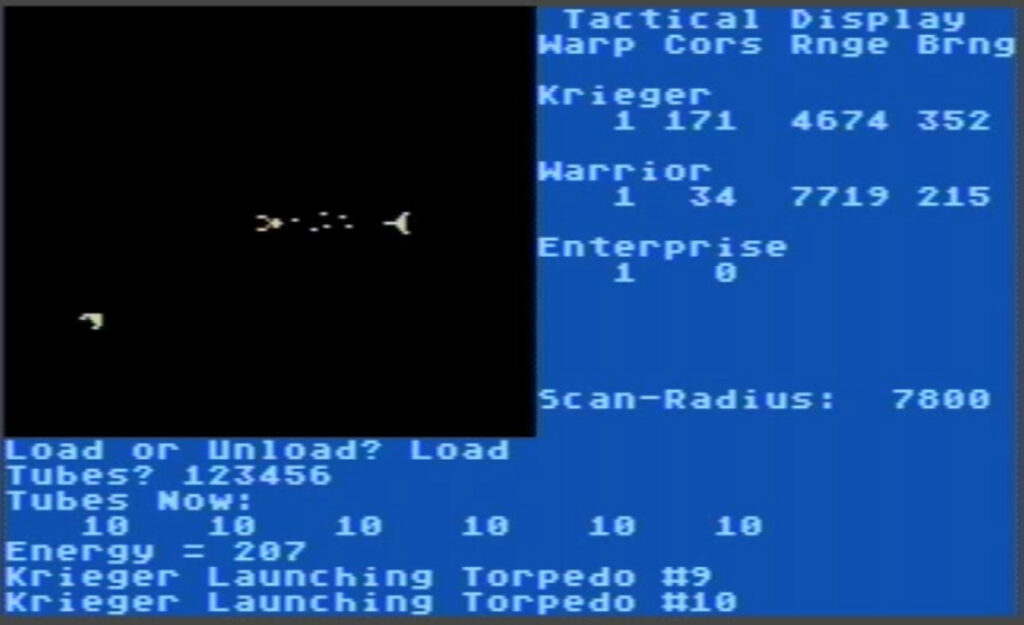
Even after 1981 and despite being ported on several languages and computer systems, Trek73 did not have the staying power of Star Trek. While inspirational, the scope for improvement was too limited and by the mid 80s Trek73 could be considered obsolete, there were better space combat games around. Today the game is mostly forgotten, overshadowed in memory by Super Star Trek.
For the purpose of this blog, I picked David Soussan’s 1985 MS-DOS version, which is mechanically close to the 1973 version but with a better narration. So let’s start the episode !
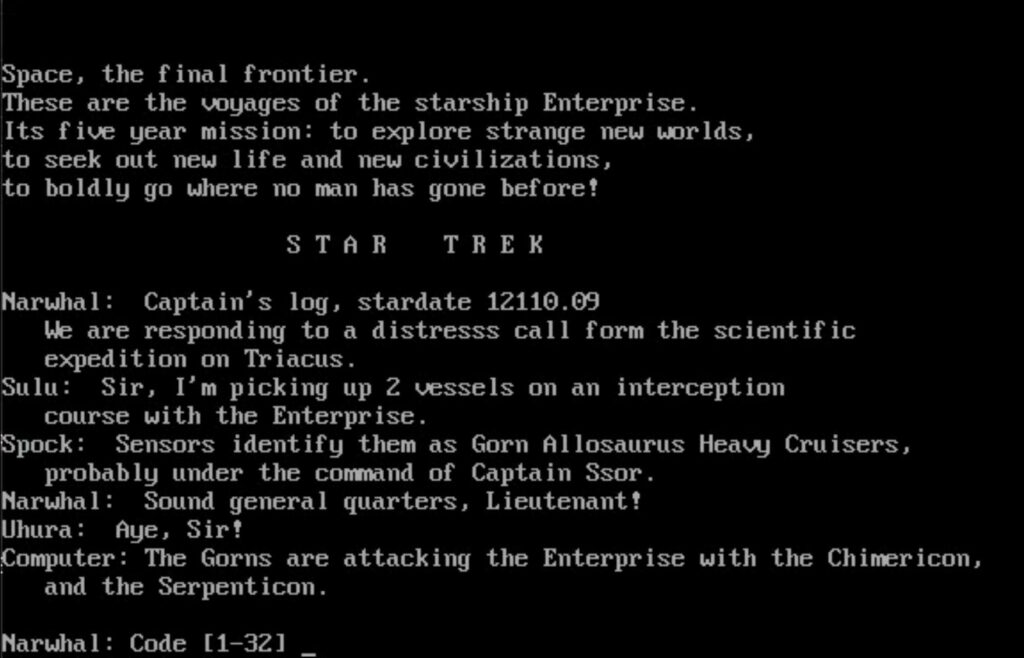
The game prompts me to give one of the 32 orders available in the game:
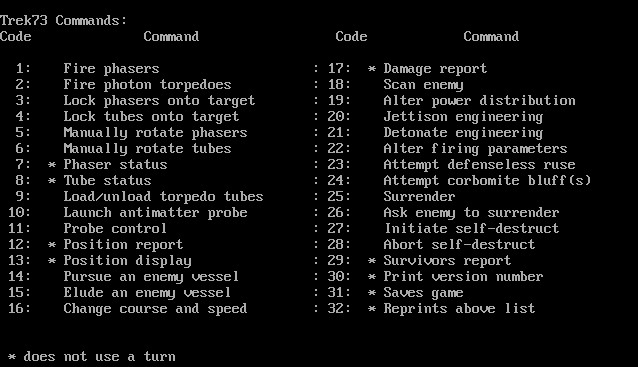
The first thing to do is assess the situation :
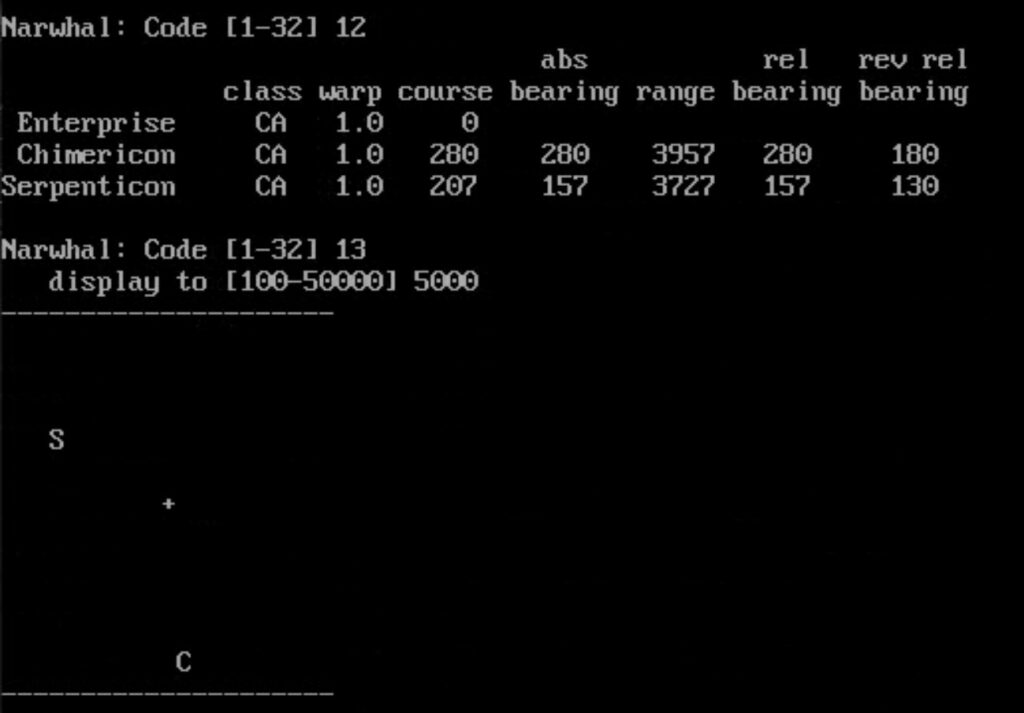
The two ships are quite distant from each other, so my plan is to first defeat the Chimericon, then turn toward the Serpenticon.
All ships start with their weapons not locked on any target and their torpedo tubes empty. In Trek73, you can only take one action per turn, so I know it will take at least 3 turns for the enemy to load their torpedo tubes, lock them on my ship and fire, and probably more as they also need to get closer. I use this time to :
- Load my own torpedo tubes,
- Lock them on the Chimericon,
- Lock 3 of my phasers on the Chimericon and one on the Serpenticon, so that last phaser can shoot at torpedoes coming from the latter.
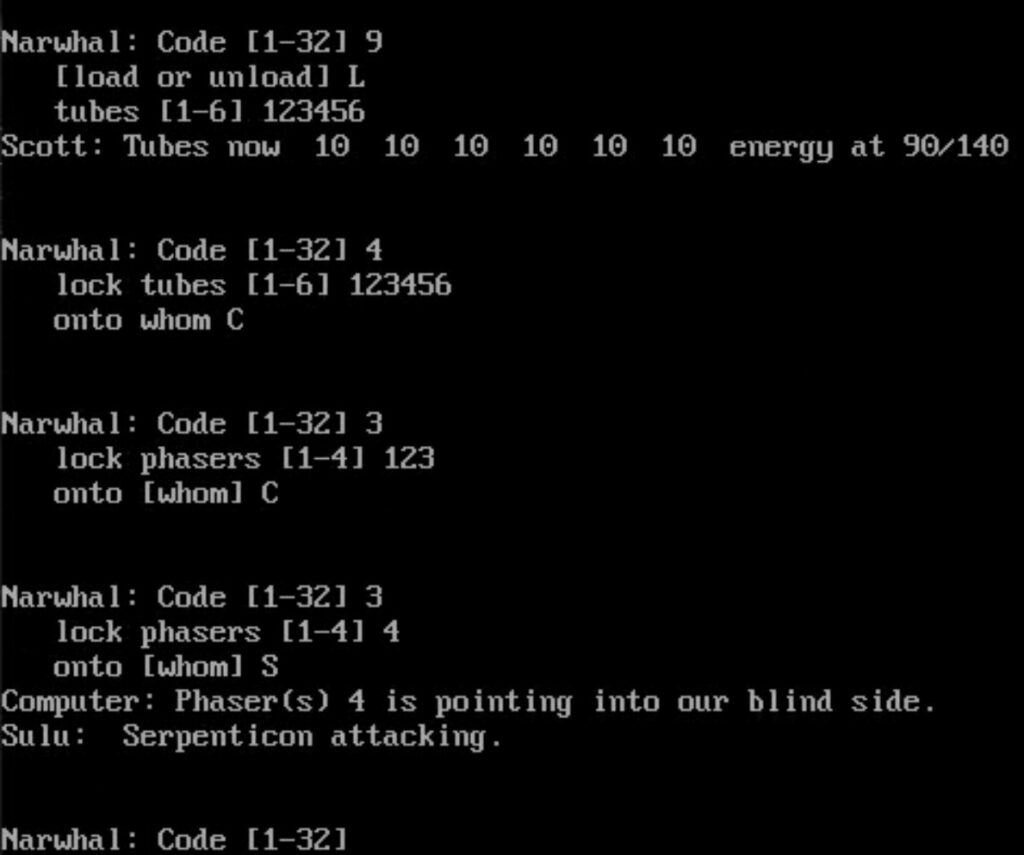
As the Serpenticon is approaching, I order Sulu to head toward the Chimericon at moderate speed and, this will be important later, to keep beelining toward it until I tell him to stop. This way, I will not have to waste turns giving new navigation orders.
Meanwhile the Chimericon sends two torpedoes in my direction !
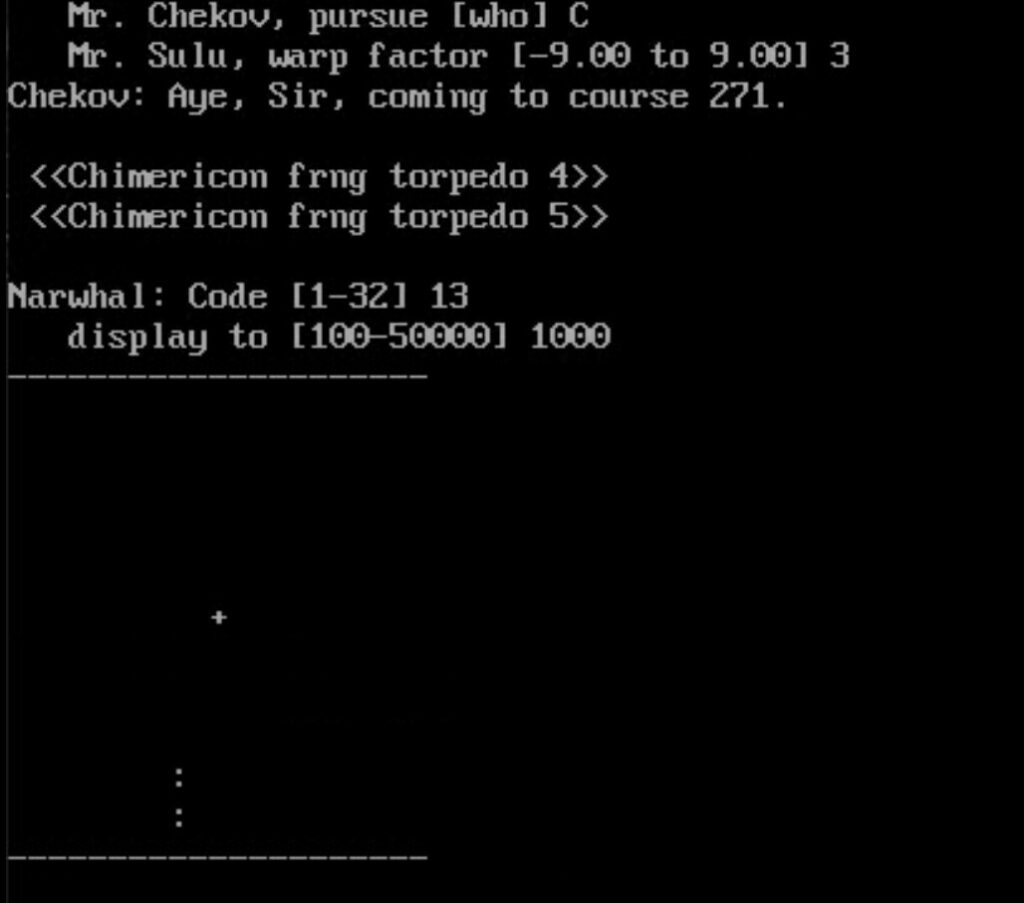
I am not worried. The torpedoes are in phaser range (1000 distance units), so I just have to shoot in the Chimericon‘s general direction, even though it is out of range, and those torpedoes will be disabled.
The good news is that I destroy the two torpedoes. The bad news is that there are more torpedoes incoming, and they hit me before I can shoot them !
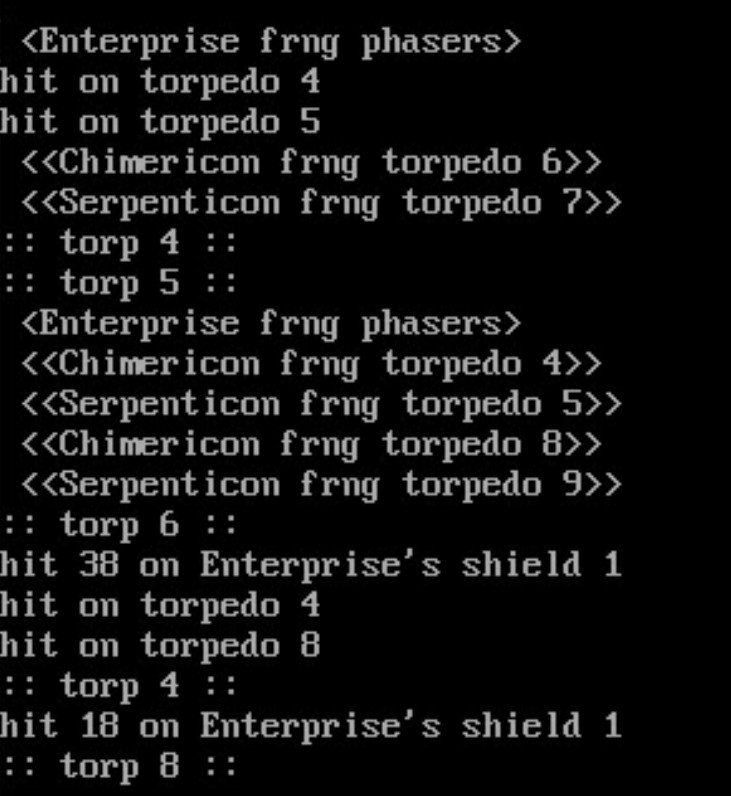
As you can see, the first torpedo (torpedo #6) exploded first, and doing so it damaged torpedoes #4 and #8. The damaged torpedo #4 still reached me, its explosion finally destroyed torpedo #8.
As for the Serpenticon‘s torpedoes, they are right behind me but actually cannot turn sharply enough to hit me !
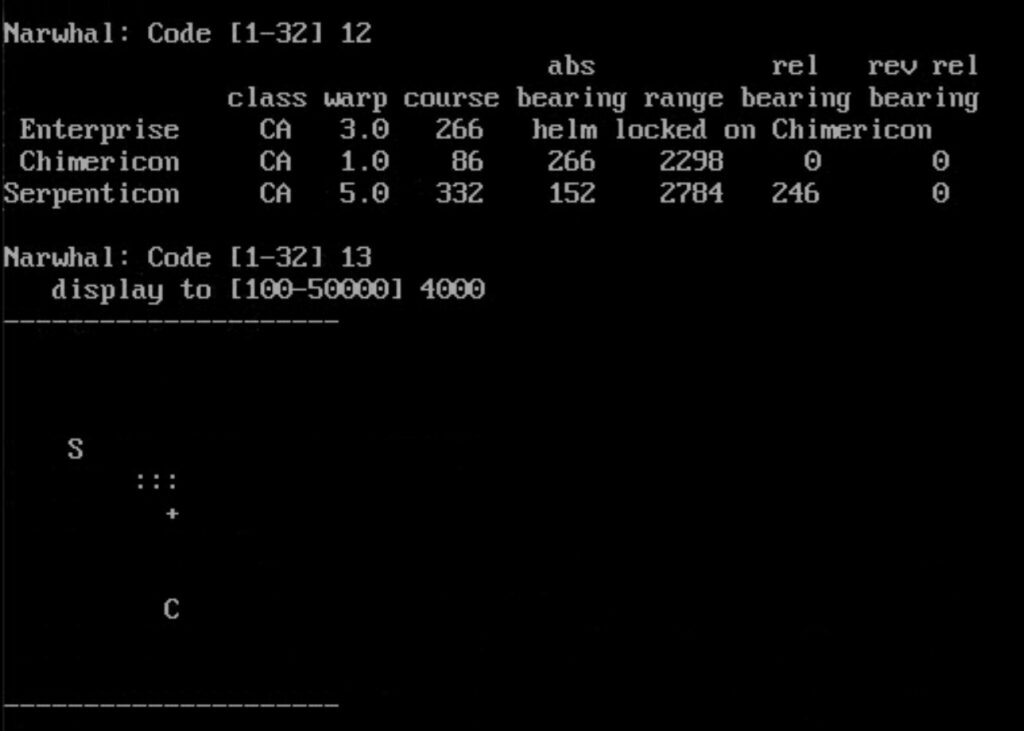
Well, my turn to send torpedoes :
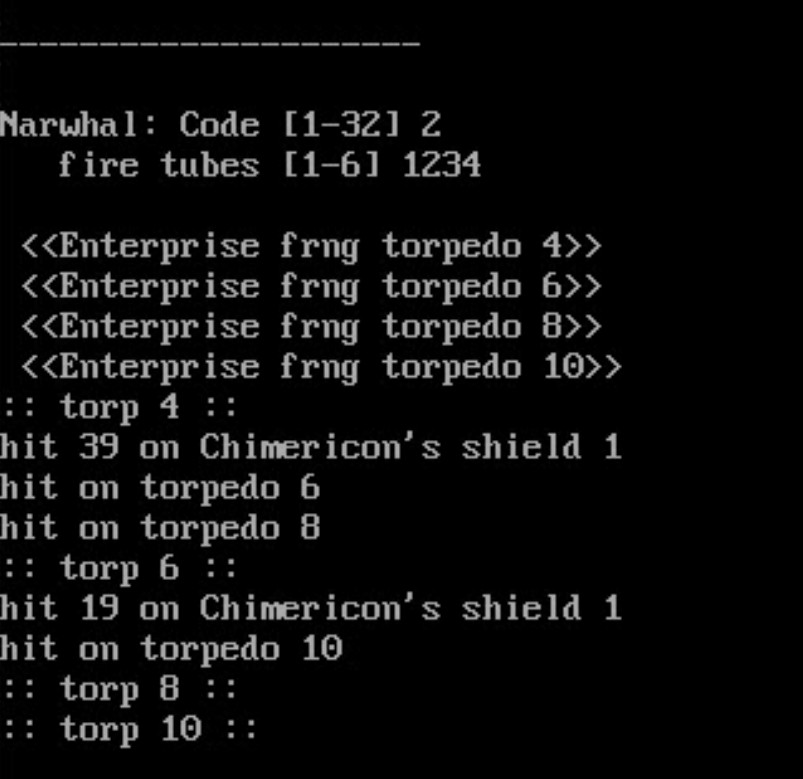
My torpedoes destroy each other as they explode, so I cause the equivalent damage of one torpedo and half. The manual advises you never to shoot more than 2 torpedoes at the same time, but I thought I knew better !
The Chimericon and the Enterprise are now at phaser range. There is no evasive action possible :
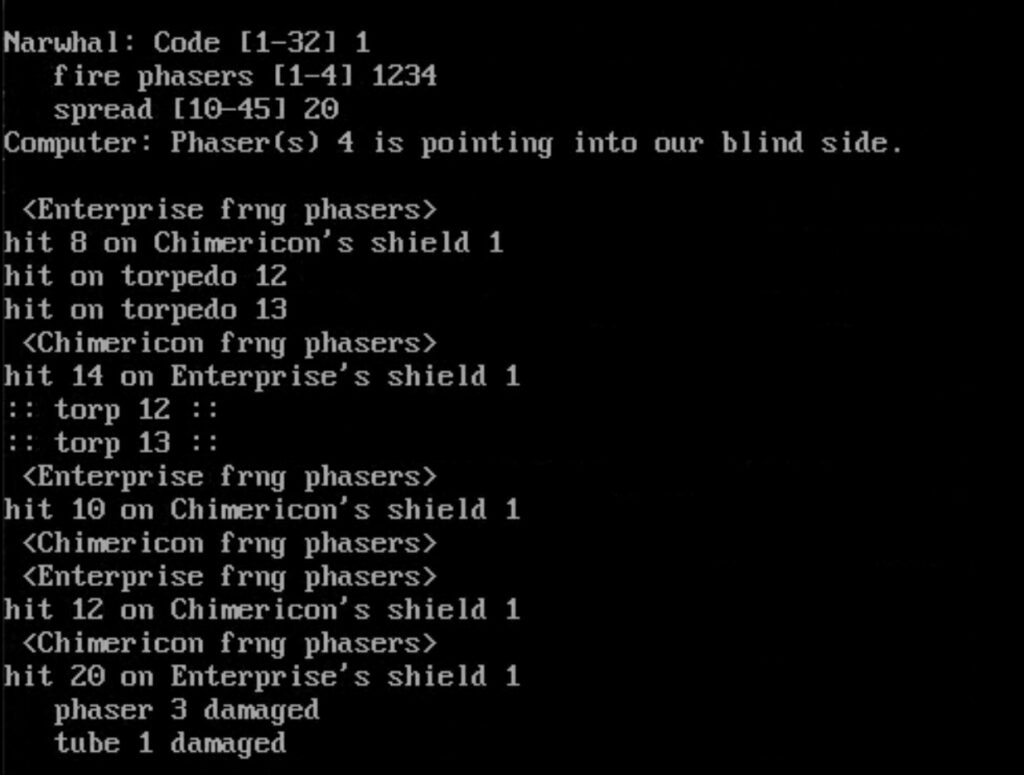
I got one phaser and one tube destroyed, and I cannot check the Chimericon’s status, because that takes a turn and I have better things to do. Like shooting.
I check the situation : still at phaser range, except the Serpenticon can now shoot as well!
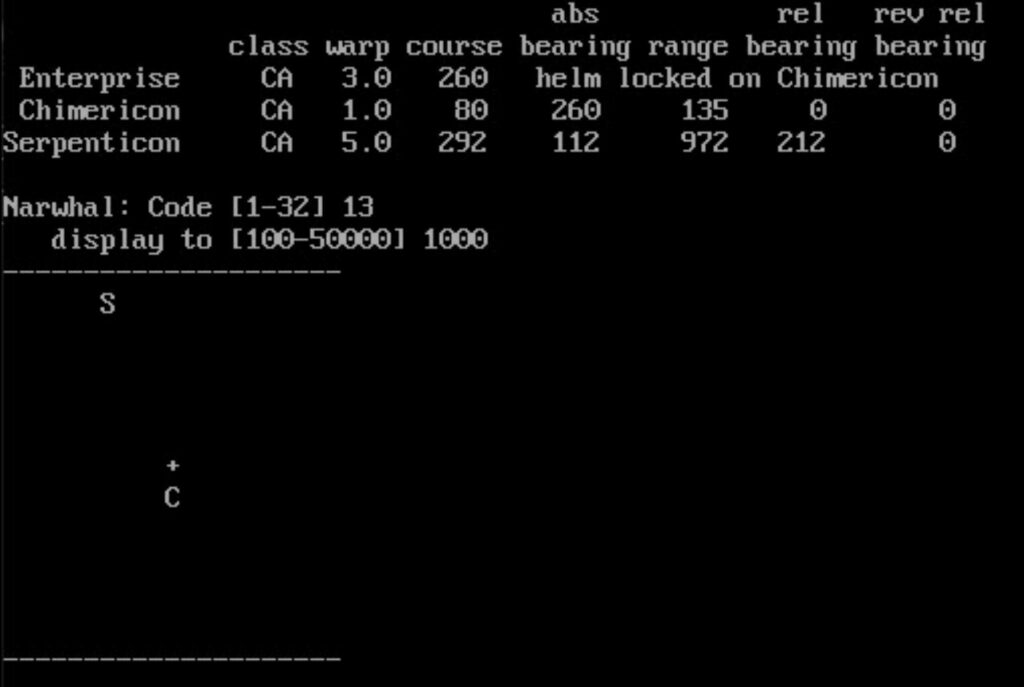
I shoot more at the Chimericon, which does not shoot back – possible all its phasers are destroyed. Meanwhile, the Serpenticon shoots at me, but I am so close to the Chimericon that both of us are hit !
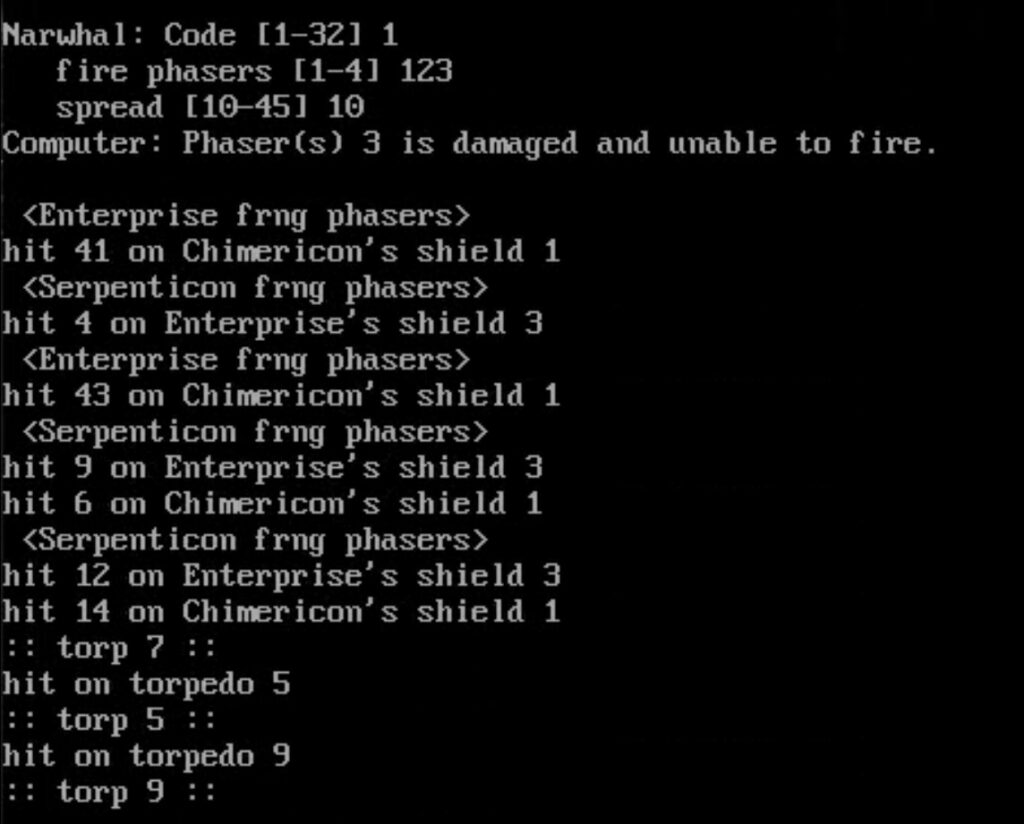
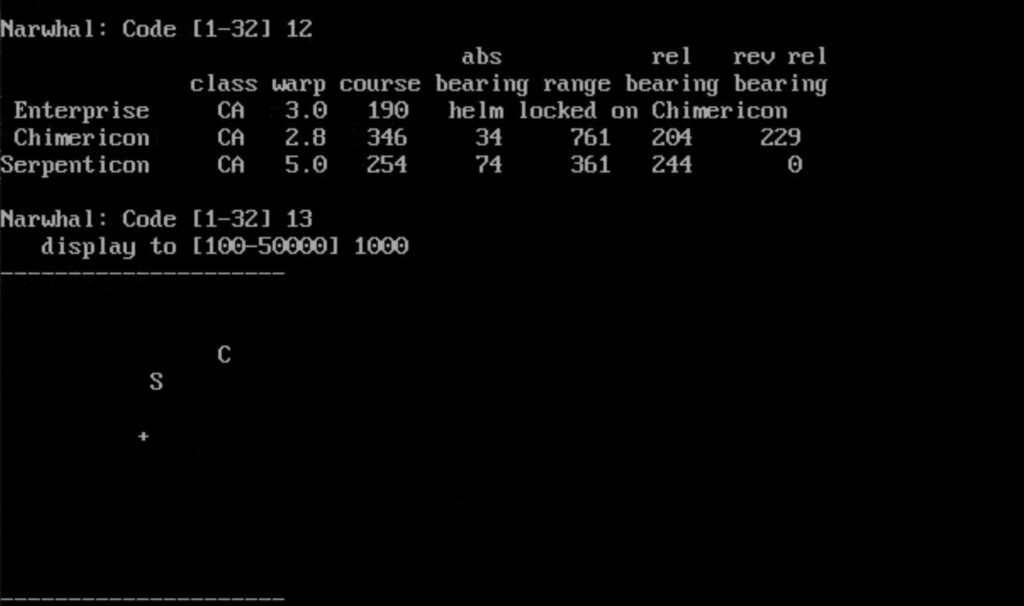
I passed the Chimericon, now I need to turn to face it. My last navigational order to Sulu is to aim for the Chimericon so it should be automatic. Meanwhile, I can load my torp…
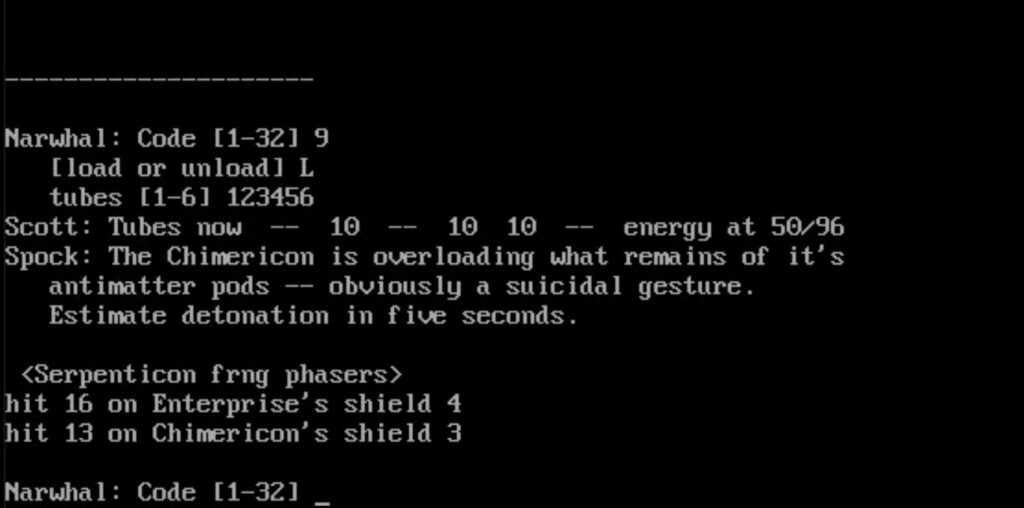
… WAIT. Someone needs to tell Sulu not to head toward the Chimericon anymore ! Of course, while I give pretty obvious instructions to Sulu, the Serpenticon can shoot at me without risks !
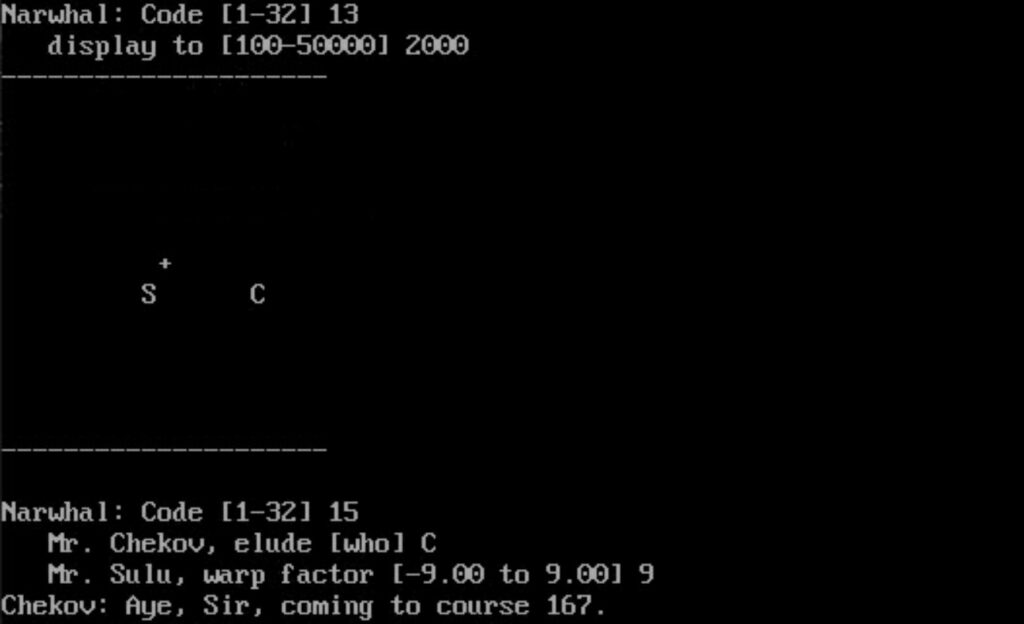

The situation is dire. I need one turn to lock my phasers on the Serpenticon, and ideally another to lock my tube torpedoes. To get those two turns, I try a “corbomite bluff” :
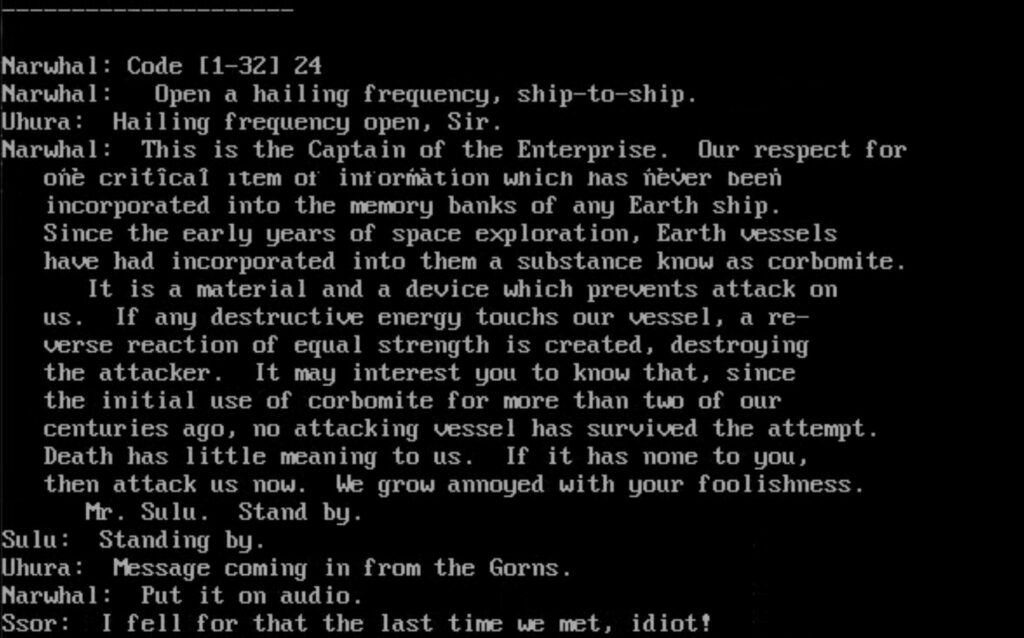
Failed ! The Chimericon explodes, badly damaging me and, it seems, the other Gorn ship !
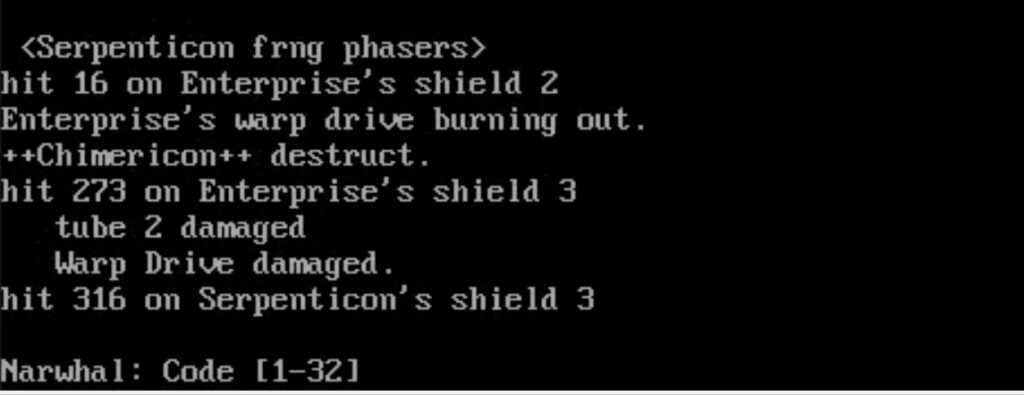
At this point, there is almost nothing left functional on my ship. But before I can surrender, the Serpenticon finishes me off !
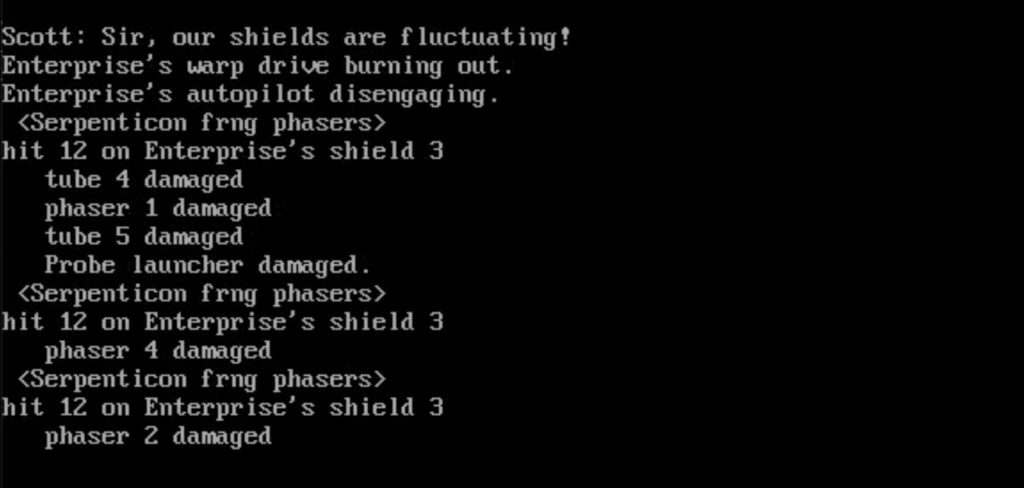
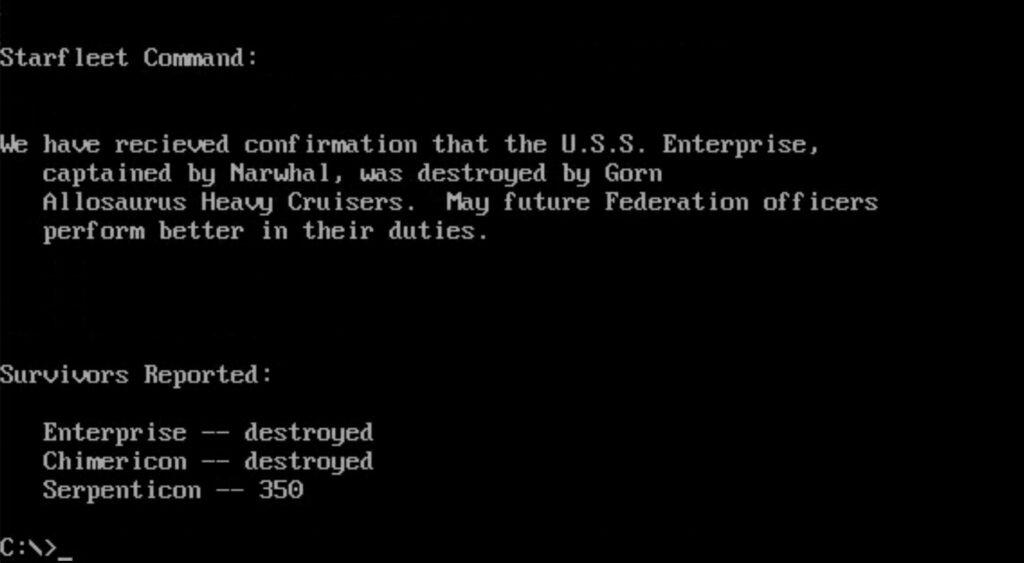
I did not live long nor prospered.
Rating and Review
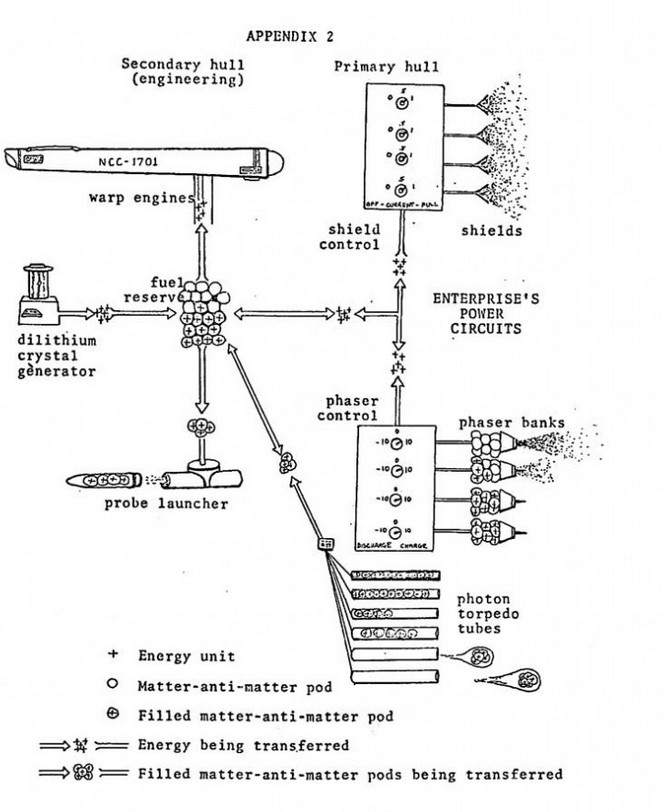
Trek73 by William Char, and then a lot of people.
First release : October 1973 on Hewlett-Packard computers
Tested on : DosBox for the 1985 version, and Atari emulator for the 1981 Tact Trek version
Total Hours Tested : 3 hours
Average duration of a battle : 10-15 minutes
Difficulty: Average (2/5)
Would recommend to a modern player : No
Would recommend to a designer : No
Final Rating: Totally obsolete
Except when specifically mentioned, my review only applies to the 1985 DOS version of Trek73 version. Both are pretty similar, with the 1985 version just adding a few more commands (31 in total, compared to 27 in 1973) and a lot of fluff.
A. Immersion
For a tactical game, Trek73 is immersive. The game generates a context for the battle among a rather diversified list, you get to fight different type of aliens who behave slightly differently, at least according to the manual (eg the Romulans don’t surrender, nor do they accept surrender) and you get in-context quips from the Enterprise crew in reaction to your actions.
The initial game only included 5 races (Klingons, Romulans, Acturians, Centaurans, Orions). The Orions were the odd ones, but maybe not so surprising as they are apparently promiscuous orc ladies from space. That’s what a friend told me. The 1985 MS-DOS version scrapped the bottom of the barrel in terms of races, and I believe even hardcore trekkies would not recognize half of the new races :

Finally, I really like the fact that you can surrender, ask for surrender, attempt totally desperate moves like jettisoning engineering and then blowing it up at distance, or play dead. If you surrender, the enemy will stop attacking but ask you to stop and drop your shield – and of course you can use that brief respite for your own purpose… or surrender for real, but that’s not what Captain Kirk would do !
Of course no graphics at all.
Rating : Quite good.
B. UI , Clarity of rules and outcomes
The commands of the game are clear, though sometimes irritating : any mistake in your order will make you lose a turn, whatever the nature of the mistake. According to the game, it is explained by your officers not understanding what you just said (or taking the time to tell you it is impossible) but it is still frustrating.
The inputs are clear, the outputs less so. The game does not tell you for instance when a torpedo is destroyed, only when it is hit. The rules about damage are explained in the manual, but in practice the outcome in-game is absolutely undecipherable. Finally, Trek73 has many game systems with complex interactions with one another, but they are not easy to check. You need to navigate through various menus to try to understand your ship situation : at the minimum position report and position display every turn, and from time to time damage report and tube status. It is tedious.
The 1985 version has a final ugly issue : you cannot scroll the text up so you cannot check what happened because it scrolled out of screen during turn resolution ; this is particularly common when you are fighting 3 ships or more. I suppose it was not an issue on teletype, but on MS-DOS it is not forgivable.
Rating : Very bad
C . Systems
Trek79 uses 2 “currencies” :
- Energy, for phasers, shield and movement. It regenerates slowly. Movement consumes energy every turn, the game is not Newtonian.
- Antimatter pods ; they store energy but are also spent when shooting torpedoes and drones (=very slow homing missiles that can only be shot one at a time). Their quantity is limited, but you should have enough for small battles, and really in Trek73 you don’t want to do anything else than small battles – let’s say 3 opponents maximum.
In theory, antimatter pods are more destructive against shields, whereas phasers are powerful against the hull. In practice, you will use the phasers at short range and antimatter pods at long range, because torpedoes and drones can be destroyed by phasers, and because you can only do one action by turn so it stops you from doing anything subtle.
The game suffers immensely from the “one action by turn” system. There are a lot of options in the game (for instance, you can change the speed of your torpedoes or how close to the target they explode), but because all they take one turn to execute, in practice you will exclude a lot of them. You are never going to have the time to spend one turn to scan the enemy, you are not going to use manual targeting because whatever you input it is going to be obsolete one turn later, you are not going to try to adjust your speed and bearing to stay behind your enemy, and you will never find the time to change your torpedoes setting either. Generally, the game fails because it often traps you in situations where the best solution is to shoot because any cool tactical move would require you to spend several turns changing direction, locking your weapons on a new target, ….
A glance at the cool options you will almost never use (from the UC Berkeley Trek73 manual) :
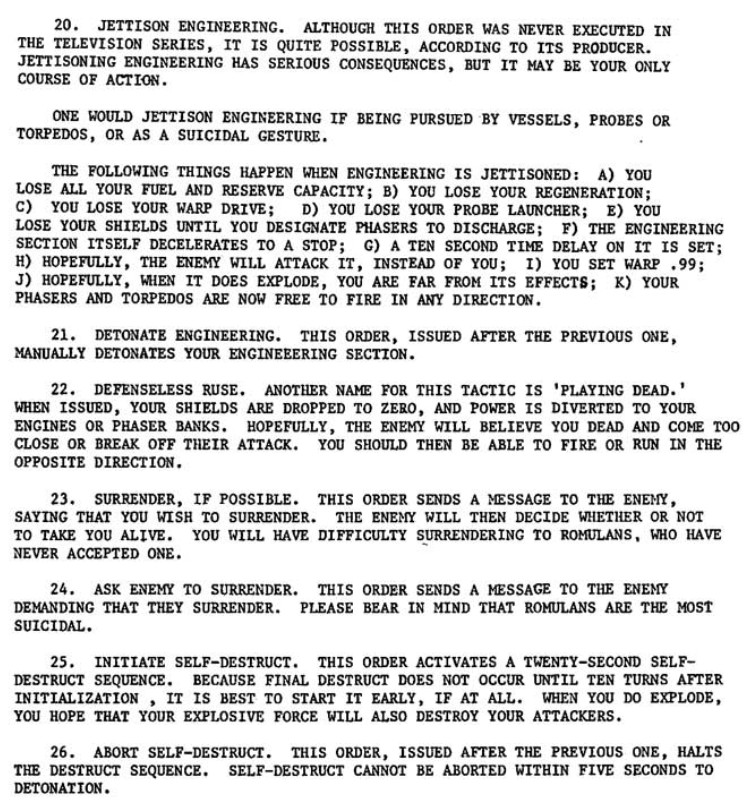
The game feels particularly unfair when destroying an enemy target: you must immediately spend one turn to lock a new target for either your phasers or torpedoes, and another to pick a new direction & bearing if you don’t want to be a sitting duck (or if your target auto-destructs).
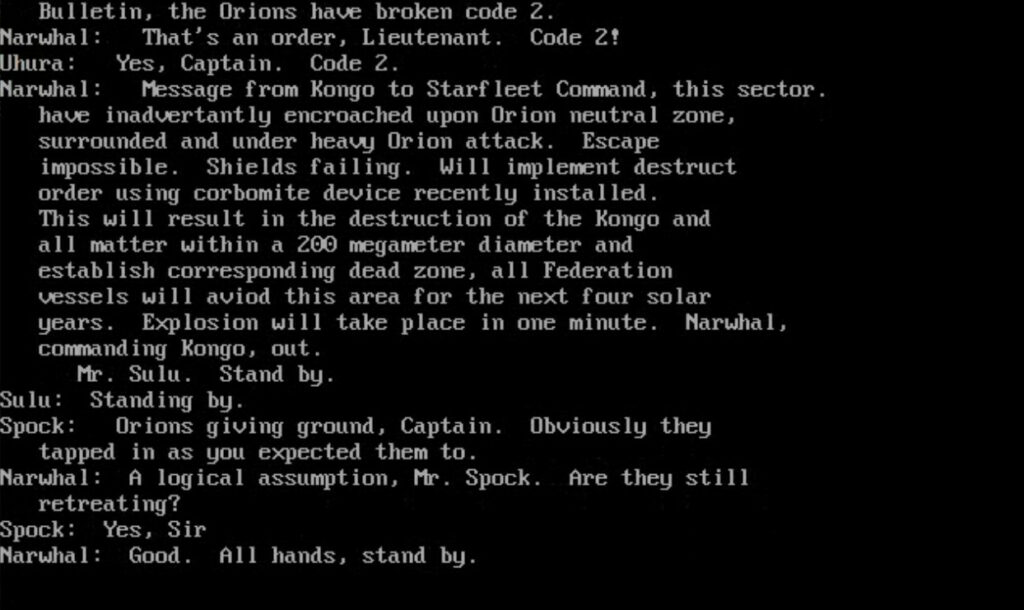
Rating : Very bad
D. Scenario design & Balancing
The only scenario design is picking up your name, your gender and how many hostiles you want to fight. The game then assigns you a ship (I got lucky to have the Enterprise) and enemies. While enemy race may be different, all the enemy ships are “Heavy Cruisers” with exactly the same stats.
The AI is not subtle : it beelines at you and shoots either torpedoes or phasers. If it can’t (because you are behind it) it will often drop a drone since these can be launched in any direction. The AI will gladly shoot at you even if some of its allies are in the way ; battles with a large number of AI ships will be endless lists of torpedoes sent by one alien hitting the ship of another alien, and only occasionally you. I even managed to destroy one ship this way without firing a shot !
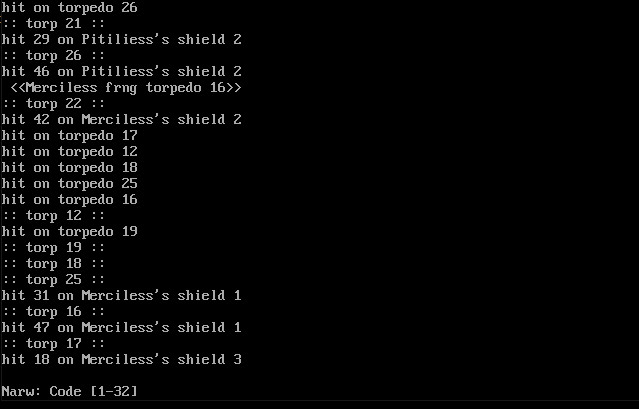
In any case, the game is trivial against one alien ship, and feels unfair against more than one : torpedoes are going to come from all directions, and if you use your phasers to stop them you cannot do anything to attack…
Rating : Very bad
E. Did I make interesting decisions ?
No. The “one decision a turn” precluded me from making interesting decisions.
F. Final rating
Totally obsolete. I understand how cool it was in 1973, but by 1980 it was made obsolete, in my opinion, by Invasion Orion which was mechanically better. In 1981, the Warp Factor is basically Trek73 with diverse ships and fewer gameplay problems.
I will not play future Trek73 clones but fear not, we are certainly not done with space battles games and obscure alien races !
3 Comments
Between the Orion sex-crazed orc ladies and the Kzinti (“Most Kzin females are sub-sapient, with a vocabulary of fewer than a hundred word/sounds and primarily instinct-driven behavior, and are treated as chattel by males” as per Wikipedia), I think some of the original Star Trek races should have been better left at the bottom of the barrel…
Come on ! How else could you meet Captain “The Cat who fought Fuzzy Bear”. How could you not WANT to photon torpedo his ship while shooting “REMEMBER FUZZY BEAR !!!!” ?
Huh. I never knew that BEGIN.EXE had any progenitors. But this clearly is one. It has a lot of the same text, drones, etc. But BEGIN.EXE was much better. You could do whole fleet battles and not much friendly fire. I always liked taking bad-ass Klingon cruisers against puny Federation ships. Different ship classes as well, Dreadnought/Cruiser/Destroyer and something called an Interceptor, which had a ton of phasers.